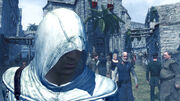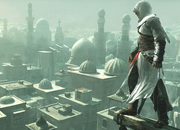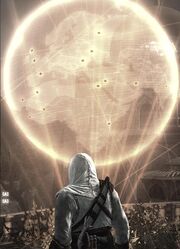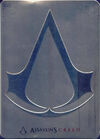[{{{网站}}} 网站]
此条目的内容是刺客信条第一部作品,关于刺客信条系列请见刺客信条(系列)。'
刺客信条是一款动作冒险类的沙盘游戏,由育碧蒙特利尔制作,育碧发行。游戏在于2007年11月在Xbox 360和PS3上推出,2008年4月推出PC版本。
游戏围绕着一个叫做Animus的机器展开。Animus可以让使用者经历他/她的祖先的记忆——在刺客信条中,戴斯蒙德·迈尔斯就经历了他生活在中世纪的祖先阿泰尔·伊本-拉阿哈德的记忆。阿泰尔的故事围绕着刺客和圣殿骑士争夺伊甸碎片展开。
刺客信条的游戏和故事都广受好评,在2006年的E3上得到了很多奖项。2009年11月,续作刺客信条II发售。
游戏性

玩家扮演中世纪刺客,阿泰尔·伊本-拉阿哈德.
《刺客信条》是一款非线性的动作类冒险游戏,玩家在其中扮演一名生活在公元12世纪,第三次十字军东征时期的叙利亚刺客 ,阿尔泰(Altaïr )。在游戏中,他的后代戴斯蒙(Desmond Miles),通过名为Animus的机器,回溯体验了他的人生。游戏的大体目标是通过执行一系列由刺客组织领袖——Al Mualim授予的刺杀任务,提升主角在刺客兄弟会中的等级。为了完成这些任务,Altaïr从组织总部马斯亚夫(Masyaf)触发,前往圣地的各个城市,例如耶路撒冷,亚克,大马士革,以及一片被称为"王国"的人烟稀少的乡间地区。
每到一个城市,Altaïr首先要找到刺客兄弟会在该城市的分部(被称作Rafiq),这可以为他提供一个落脚点和藏身处(称作Bureau),并获得目标的大致信息。进一步的情报收集工作需要用Altaïr自己来进行,通过偷窃和窃听(eavesdropping ),殴打讯问(interrogation ),会见情报提供者及刺客同伴,或是收集一些重要的物品。Altaïr必须收集到足够的情报,才能够安全顺利地完成刺杀任务。任务完成后,Altaïr回到兄弟会总部,获得更高级的装备作为奖赏,并接受下一个任务。

鸟瞰点
在执行主线任务时,Desmond需要操控Altaïr到达城市的一些制高点(称为鸟瞰点)以补充对当前所在城市地图的同步。其他的一些任务,如跟踪并杀掉圣殿武士,收集旗帜,拯救被卫兵攻击的平民。
多数情况下,Altaïr必须完成他的任务而不被当局人员发现。游戏使用了“警觉度量计”(Alertness Level Meter)来表示周围的人,尤其是卫兵,对Altaïr的警觉程度——界面上方Abstergo公司的Logo会随之改变颜色和形状。 某一动作在一个特定时候会引起警觉度提升,而在另一个时候则不会。如果一个地区进入了高度警戒(界面上方的logo会变红,整个同步率条的背景色也会变红。),那么周围的市民们会惊慌地四散奔逃,城市的卫兵们会警惕地四处搜寻并主动攻击Altaïr。为了降低周围的警戒性,Altaïr必须躲开卫兵的视线,寻找躲藏点,混入与他穿着很相近的学者们中,或是与平民一起坐在长凳上以伪装自己。

跑酷
为了完成刺杀任务以及许多支线任务,Altaïr有两种行为方式可供选择——这会影响周围人对他的警觉度。低调行动,包括混入人群,躲避,或使用袖剑进行低调的暗杀。高调行动,如自由奔跑,攻击敌人,以及高调暗杀,会提升周围地区的警觉度。当你不得不面对众多敌人的时候,那么试试Altaïr高超的格斗技巧吧。
在游戏中,健康程度用“同步程度”来表示——这指的是Desmond与Altaïr记忆之间的同步程度。当Altaïr受伤时,这会被视为脱离了真实的记忆,于是引起同步率下降。完全失去同步时,Desmond当前的记忆回溯就会被打断,并从上一个检查点重新载入。全部同步完成时,Desmond就可以像Altaïr一样使用"鹰眼视觉",敌人,朋友和平民都会被不同的高亮颜色标记,并看到一些肉眼看不见的东西。
由于Altaïr的记忆是由计算机模拟出来的,因此小故障和出错提示会经常出现。如果玩家的反应足够快,这些小故障可以被用来识别目标,或是利用过场动画的时间为自己创造有利条件。
情节

Warren Vidic of Abstergo Industries overlooks Desmond inside the Animus.
戴斯蒙.迈尔斯(Desmond Miles )是一名纽约的酒保。一家名为阿伯斯特戈工业(Abstergo Industries)的公司绑架了他以作为Animus项目的实验体。animus是一种能够激发关于祖先的记忆的机器。Abstergo把Desmond放入其中,以获得他的一个祖先,Altaïr Ibn-La'Ahad的记忆。Altair是一名1191年第三次十字军东征时期,生活在圣地地区的刺客兄弟会成员。Desmond一开始不太适应这台机器,不过他在接下来的几天里最终重现了altair一生的事迹。游戏主要采用了Altaïr的视角,有时会因为Animus的小故障而切换回Desmond的视角。
游戏开始时,Desmond进入到Altaïr的记忆中,但遇到了同步率问题,这时候还可以听到机器以外Lucy和Vidic的对话。很快Desmond因错误而退出了Animus。Vidic给了他一些关于Animus的简短介绍,然后让他进入了一个教程程序。Desmond完成教程之后就进入了Altaïr的第一段记忆。Lucy说Desmond必须先完成一系列的记忆以提高同步率,这样才能获得圣殿骑士们想要的最终记忆。
Altaïr首先在马利克(Malik)和他的兄弟的帮助下,试图从所罗门神殿取回一些被称为"伊甸圣器"的宝物。但这一行为被罗伯特(Robert de Sable),圣殿骑士的导师和刺客组织最大的敌人,所阻止。在这次任务中,Altaïr违背了所有三条刺客的信条 ("不杀无辜," "低调行事" 和 "不危及兄弟会")。在游戏刚开始的时候,他试图杀死罗伯特,但失败了。接下来,malik失去了他的兄弟,以及左臂。当Altaïr满怀歉意地回到刺客的大本营马斯亚夫时,Malik,从罗伯特那儿生还,带着圣物,以及对altair的骄傲自大的满腔怨恨。

Altaïr, Rauf and another Assassin performing Leaps of Faith before the defeated Templars.
艰难地抵抗了圣殿骑士的攻击之后,阿尔穆林,刺客组织的领导者,把Altaïr降级为初学者,但给了他一个重新升级的机会。阿尔穆林命令Altaïr分别在耶路撒冷,亚克,和大马士革暗杀圣地地区最关键的九个人物,以期在十字军和撒拉逊人之间带来和平。每个人物都是由第三次十字军东征时期的历史人物改编的,包括 马吉德·亚丁 (Regent of Jerusalem), Garnier de Naplouse (Grand Master of the Hospitalier), Jubair al Hakim (an eminent scholar in Damascus), Abu'l Nuqoud (the wealthiest man in Damascus), Robert de Sable(Grand Master Sibrand of the Knights Teutonic)and William of Montferrat (Regent of Acre)。

阿泰尔来到阿尔苏夫
Altaïr完成了每一个任务,同时注意到了他们每个人与罗伯特以及圣殿骑士之间的关系,发现他们一致地试图停止圣战然后将圣地置于他们的统治之下。随着两个阵营的人陆续被他杀死,他发现罗伯特的终极目标是联合基督徒和撒拉逊人的势力,共同对抗他们的新敌人——刺客们。在由狮心王理查主持的决斗中,Altaïr打败了罗伯特,但没能说服查理王相信双方都期望着这场战争的结束。从罗伯特口中,altair得知他的师父阿尔穆林本身就是一个圣殿骑士,他利用altair杀掉其他人以达到独占宝物的目的。

Altaïr discovers a map detailing the locations of other Pieces of Eden.
Altaïr迅速回到马斯亚夫与导师对质,得知了事情的真相:伊甸碎片(Piece of Eden,which he had received from one of the men in the library after Altaïr's transgression)能够创造幻象,统治人的思想。阿尔莫林把宗教圣迹和其他一些超自然现象(例如埃及大瘟疫,分开红海,特洛伊战争中希腊众神显圣等)解释为碎片产生的幻象。他的目的是利用伊甸碎片的力量将人类置于被洗脑的状态之下,以结束一切纷争。Altaïr最终识破了碎片创造的幻象,杀死了阿尔莫林。当他靠近碎片时,碎片被激活,投影出一幅地球的全息影像,上面标明了散落在世界各地的其他碎片的位置。
这个过程结束后,Desmond发现Abstergo其实是现代的圣殿骑士组织,他们已经在Altair记忆中标出的那些地点寻找其他伊甸碎片了。同时他还得知,当代刺客组织在记忆完成之前已经开始尝试营救他,但未能成功。记忆完成后圣殿骑士想要杀掉Desmond,但研究员露西(Lucy Stillman)的提议保全了他的性命。无人注意的时候,露西向Desmond伸出自己的手,同时把无名指弯进手掌,看起来如同古代刺客按照传统切去了无名指一样,暗示Desmond她其实是一名刺客。
尽管Desmond仍然被困在Abstergo实验室,但他在Animus中的经历给了他"出血效应",他的身体表现出了Altair的特质,能够使用"鹰眼视觉"。于是他看见了涂抹在实验室墙上和地上的神秘信息。这些信息表现了世界各地文化对世界末日的猜想,其中包括了2012年12月21的末日传言,以及Abstergo即将发射一颗“能够永远停止战争”的卫星的计划。这暗示着,他们将会采用与阿尔莫林控制马斯亚夫时同样的方法,只是规模大得多。游戏结束时,Desmond正在思考这些奇怪的涂鸦是何人所为。事实上他们是16号实验体用自己的血画的。
Development
Game Development
| System requirements | |||
|---|---|---|---|
|
In one of the original interviews with IGN, game producer Jade Raymond described Altaïr as a "medieval hitman" with a "mysterious past" and definitely not a time traveler. In October 2007, IGN Australia interview described the lead character's ability to climb and free run as being designed by the individuals who designed the same for the Prince of Persia.
In December 2006, Kristen Bell who voiced Abstergo researcher and employee Lucy Stillman, gave the first concrete information about the plot, confirming a focus on genetic memory and a corporation's search for descendants of an assassin.[1]
Ubisoft also released "developer's diary" videos on the game's website with members of the development team, including creative director Patrice Désilets and producer Jade Raymond, explaining the thought processes behind the various aspects of the game.[2]
Soundtrack Development
The musical score for Assassin's Creed was composed by Jesper Kyd and the entire soundtrack was developed to "capture the gruesome atmosphere of medieval warfare but also be edgy and contemporary."[3] The score was written to contain orchestral music with dark and ominous overtones. Many of the tracks also contain choruses and vocal tracks in Latin to cement the darker elements of the game and the time period of the game's setting.
Six tracks were released on the Ubisoft website for those individuals who purchased the game. The soundtrack is also available in iTunes Music Store and Amazon MP3.
Editions
Limited Edition

PS3 European Limited Edition of Assassin's Creed.
A limited collector's edition of the game was released in North America alongside the standard release. The North American edition contains a collectible three inch Altaïr, Penny Arcade Comic, a mini strategy guide and a bonus disc. The bonus disc includes behind the scenes videos, developer diaries, trailers, production team interviews, and the winners of the Assassin's Creed short film contest.

The cover of the steelbox
A European limited edition of the game was also released which included a twelve inch Altaïr figure, art book, and bonus disc. The bonus disc contains several short films and content similar to the North American version.
In addition to the game, a steelbox was released, which held the Assassin's Creed: Graphic Novel, a bonus disc and a certificate of authenticity. It was decorated with the Assassin insignia and animus effect symbols, while on its back a picture of Altaïr was displayed. The steelbox left space to insert the game itself (of any platform) as it was not included.

Assassin's Creed: Director's Cut Edition Box Art (PC Only)
导演剪辑版(仅限PC)
This version features four PC-exclusive missions, including the Rooftop Race Challenge, the Archer Stealth Assassination Challenge, etc.
Prequel and Sequels
On February 5, 2008, Assassin's Creed: Altaïr's Chronicles was released for Nintendo DS as a prequel for Assassin's Creed. Developed by Gameloft, a mobile version was released for the iPhone and iPod Touch in April 2009.
In January 2009, Ubisoft confirmed the production of Assassin's Creed II, which was released for the Xbox 360 and PlayStation 3 in November 2009. The sequel continues the story started in Assassin's Creed with a different set of genetic memories created to be explored by the player.
At the same time Assassin's Creed: Bloodlines was released for the PSP, which was another spin-off game as Assassin's Creed: Altaïr's Chronicles, where the story of Altaïr continued a month after the first game. The style of the graphics and the gameplay also resembled the first game more than its predecessor Assassin's Creed: Altaïr's Chronicles.
In November 2010, Assassin's Creed: Brotherhood was released. It continues the story of Ezio Auditore from Assassin's Creed II and the modern day Assassins' story. It is also the first full game in the series to feature a multiplayer mode.
In November 2011 Assassin's Creed: Revelations was released. The story of Ezio comes to a close when Ezio travels to Constantinople to find the five keys to Altaïr's library under Masyaf castle. The keys also allow Ezio to see memories of Altaïr's life preceding and following the events of the first game. This allows the player to once again play as Altaïr.
Awards
|
|
|
Trivia
- The game's timeline spans roughly two months, from July (around after the Crusader victory in the siege of Acre) to early September (right before the battle of Arsuf).[4][5]
- The Assassins are based on an Islamic sect known as the Order of the Hashshashin from which the term assassin originates, the idea for it coming from Blitzkrieg to Desert Storm: The Evolution of Operational Warfare by Robert M. Citino, along with Vladimir Bartol's novel Alamut.[6]
- The siege of Masyaf borrows elements from Vladimir Bartol's novel. In the novel the leader of the Assassins orders two of his men to kill themselves as a demonstration of his power. The two men jump from a tower with smiles on their faces, much in the same way Altaïr did.
- One of the key inspirations of Raphael Lacoste, the art director and production designer of Assassin's Creed, was Orientalist paintings, particularly the lithographs of the Holy Land and Syria by David Roberts.
- The popular phrase used to describe Assassin's Creed's gameplay "Laa shay'a waqui'n moutlaq bale kouloun moumkine" is Arabic for "Nothing is true. Everything is permitted." This quote is generally attributed to the founder of the Hashshashin, Hassan-i Sabbah.[7]
References
| ||||||||||||||||||||||||||||
| |||||||||||||||||||||||||||||||||||||||
